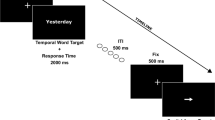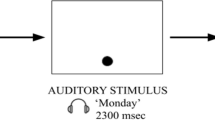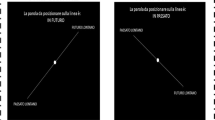Abstract
English speakers use horizontal spatial metaphors (e.g., before/after) to talk about time relative to vertical spatial metaphors (e.g., up/down), so they may be faster in verifying temporal targets (e.g., June comes after April) that are preceded by primes that activate horizontal, relative to vertical, spatial metaphors. We examined this horizontal bias by comparing the effect of horizontal versus vertical arrows as primes on judging the validity of pure temporal targets (e.g., June is earlier/later than April) versus spatiotemporal targets (e.g., June comes before/after April). The horizontal bias occurred for both types of targets, and participants were faster when the arrow direction (e.g., right pointing; arrow flying from left to right) was congruent with the meaning of relation words in the temporal targets (e.g., later—time flowing from the past to the future) than when it was incongruent, consistent with the view of the left–past/right–future representation of time.
Similar content being viewed by others
References
BORODITSKY, L. (2000). Metaphoric structuring: Understanding time through spatial metaphors. Cognition, 75, 1–28. doi: 10.1016/S0010-0277(99)00073-6
BORODITSKY, L. (2001). does language shape thought?: Mandarin and English speakers’ conceptions of time. Cognitive Psychology, 43, 1–22. doi: 10.1006/cogp.2001.0748
BORODITSKY, L., FUHRMAN, O., & MCCORMICK, K. (2011). do English and Mandarin speakers think differently about time? Cognition, 118, 123–129. doi: 10.1016 /j.cognition.2010.09.010
CASASANTO, D. (2009). space for thinking. in V. Evans & P. Chilton (Eds.), Language, cognition and space: State of the art and new directions (pp. 453–478). London, UK: Equinox.
CASASANTO, D., & BORODITSKY, L. (2008). Time in the mind: Using space to think about time. Cognition, 106, 579–593. doi: 10.1016/j.cognition.2007.03.004
CHEN, J. Y. (2007). Do Chinese and English speakers think about time differently? Failure of replicating boroditsky (2001). Cognition, 104, 427–436. doi: 10.1016/j.cognition.2006.09.012
CLARK, H. H. (1973). Space, time, semantics and the child. in T. E. Moore (Ed.), Cognitive development and the acquisition of language (pp. 27–63). New York, NY: Academic Press.
FUHRMAN, O., & BORODITSKY, L. (2010). Cross-cultural differences in mental representations of time: Evidence from an implicit non-linguistic task. Cognitive Science, 34, 1430–1451. doi: 10.1111/j.1551-6709.2010.01105.x
GENTNER, D., IMAI, M., & BORODITSKY, L. (2002). as time goes by: Evidence for two systems in processing space time metaphors. Language and Cognitive Processes, 17, 537–565. doi: 10.1080/01690960143000317
GEVERS, W., REYNVOET, B., & FIAS, W. (2004). The mental representation of ordinal sequences is spatially organized: Evidence from days of the week. Cortex, 40, 171–172. doi: 10.1016/S0010-0277(02)00234-2
GIBBS, R (1996). Why many concepts are metaphorical. Cognition, 61, 309–319. doi: 10.1016/S0010-0277(96)00723-8
JANUARY, D., & KAKO, E (2007). Re-evaluating evidence for the linguistic relativity hypothesis: response to boroditsky (2001). Cognition, 104, 417–426. doi: 10.1016/j.cognition.2006.07.008
LAKOFF, G., & JOHNSON, M. (1980). Metaphors we live by. Chicago, IL: University of Chicago Press.
OUELLET, M., SANTIAGO, J., FUNES, M. J., & LUPIÁÑEZ, J. (2010). Thinking about the future moves attention to the right. Journal of Experimental Psychology: Human Perception and Performance, 36, 17–24. doi: 10.1037/a0017176
OUELLET, M., SANTIAGO, J., ISRAELI, Z., & GABAY, S. (2010). Is the future the right time? Experimental Psychology, 57, 308–314. doi: 10.1027/1618-3169/a000036
SANTIAGO, J., LUPIÁÑEZ, J., PÉREZ, E., & FNES, M. J. (2007). Time (also) fies from left to right. Psychonomic Bulletin & Review, 14, 512–516. doi: 10.3758/bF03194099
SANTIAGO, J., ROMÁN, A., OUELLET, M., RODRÍGUEZ, N., & PÉREZ-AZOR, P (2010). In hindsight, life fows from left to right. Psychological Research, 74, 59–70. doi: 10.1007/s00426-008-0220-0
STANDING, L., CONEZIO, J., & HABER, R N. (1970). Perception and memory for pictures: Single-trial learning of 2500 visual stimuli. Psychonomic Science, 19, 73–74.
TORRALBO, A., SANTIAGO, J., & LUPIÁÑEZ, J. (2006). Flexible conceptual projection of time onto spatial frames of reference. Cognitive Science, 30, 745–757. doi: 10.1207/s15516709cog0000_67
TSE, C.-S. (2008). Automatic activation of spatial-numerical association in a primed parity judgment task: Evidence from the number-line congruency effect. European Journal of Cognitive Psychology, 20, 847–866. doi: 10.1080/09541440701577426
TSE, C.-S., & ALTARRIBA, J. (2008). Evidence against linguistic relativity in Chinese and English: a case study of spatial and temporal metaphors. Journal of Cognition and Culture, 8, 335–357. doi: 10.1163/156853708X358218
TSE, C.-S., & ALTARRIBA, J. (2010). The revelation of the negative side of a mental number line depends on list context: Evidence from a sign priming paradigm. European Journal of Cognitive Psychology, 22, 1248–1260. doi: 10.1080/09541440903427495
TVERSKY, B., KUGELMASS, S., & WINTER, A. (1991). Cross-cultural and developmental trends in graphic productions. Cognitive Psychology, 23, 515–557. doi: 10.1016/0010-0285(91)90005-9
WEGER, U., & PRATT, J. (2008). Time fies like an arrow: space-time compatibility effects suggest the use of a mental time-line. Psychonomic Bulletin & Review, 15, 426–430. doi: 10.3758/pbr.15.2.426
Author information
Authors and Affiliations
Corresponding author
Rights and permissions
About this article
Cite this article
Tse, CS., Altarriba, J. Recognizing the Directionality of an Arrow Affects Subsequent Judgments of a Temporal Statement: The Role of Directionality in Spatial Metaphors. Psychol Rec 62, 497–506 (2012). https://doi.org/10.1007/BF03395816
Published:
Issue Date:
DOI: https://doi.org/10.1007/BF03395816




